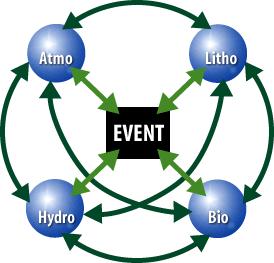Week
B: Teacher as Model Builder—Team
ESS
Model-Building Rubric
Weeks
5, 8,
11, and 14
Goal:
Use your team's original or revised problem statement, build
an ESS model that includes the ESS relationship statements
and evidence that support your conclusions (recommendations
or solutions).
Background:
Based on your collective knowledge and the answers to your
questions in Week A, create an ESS model as a team. Discuss
what you learned and what conclusions you can support with
evidence from multiple sources including observation, expert
opinion, analogy, or experimental results.
"Does
that make sense?" you ask. Negotiated meaning is at the
heart of developing meaning. We can memorize on our own, but
we need to talk or write about our ideas to refine them.
So how
does negotiated meaning work? Doesn't the loudest, oldest,
or smartest voice usually dominate? Isn't there a right answer?
Why should you entertain ideas you don't agree with? Consider
these three reasons:
- Some
say truth has its own life - that we have only to discover
it, so when the same idea emerges from different people's
thinking for different reasons, it often points toward the
truth.
- Language
gives life to thought and, in doing so, changes it. In a
team, your job is to be sure that you are understood. Is
what your teammates heard what you meant? Feedback from
them about what they heard pushes you to be clearer in your
communication and your thinking.
- Seeing
how ideas filter through other people's minds gives you
a perspective you can only imagine on your own. What ideas
do others find most compelling? Why? How do ideas fit together
for them? What do they find to be problematic? What are
they curious about? Tell them what you hear them saying
and do your best to understand what they mean. If you can
live inside their perspectives, they will expand your own.
Remember,
a model satisfies a broader audience than your own mind. The
evolution of private theories into models is the social learning
phenomenon that Vygotsky identified and is the outcome of
Problem-Based Learning. Building a model takes reflection
and dialectic. The trick is to stay curious rather than to
become judgmental and critical of others' ideas. When you
become judgmental and critical, you are probably hanging on
to those private theories a little too tenaciously.
Think
like an investigator, trying to discover, rather than deciding
what to think. Use your teammates to keep you honest about
the quality of your ideas and to expand your sense of the
possibilities.

Rubric
Your team Week B: Teacher as Model Builder assignment
corresponds to PBL Steps 7 and 8. The rubric below assesses
how well you build a team model that supports your findings.
You can
earn as many as nine points for this assignment. You will
automatically earn one point for submitting your assignment
on time (see the Time Rubric).
Use the criteria and indicators
below to gauge your success in earning the remaining
eight
points.
| Support:
Clarity
and focus of supportable ideas and conclusions
|
4
Rating:
Develop
a comprehensive summary of supportable ideas and conclusions
that go beyond the facts to show insight into the systemic
relationships. |
3
Rating:
Develop
an accurate summary of supportable ideas and conclusions
with insight beyond the facts.
|
2
Rating:
List
some supportable ideas and conclusions beyond the facts
that summarize the overall causes and effects. |
1
Rating:
List
ideas and conclusions, but does not summarize the overall
causes and effects or fails to go beyond the facts. |
| Relationship Statements: Number,
accuracy, and thoroughness of relationship statements
(assertions) in causal chains |
4
Rating:
Reveal
a thorough understanding of the Earth System Diagram through
your analyses by asserting in full detail the impact of
the event on the spheres, the interactions among spheres,
and the return effect on the event itself in causal chains. |
3
Rating:
Reveal
a satisfactory understanding of the Earth System Diagram
through your analyses by detailing causal chains involving
all the spheres (at least S>S>S). |
2
Rating:
Reveal
some understanding of the Earth System Diagram through
defining causal chains and supporting them. |
1
Rating:
Show
some understanding of the Earth System Diagram through
your analysis by describing causal relationships. |
| Evidence: Scope,
detail and accuracy of the evidence supporting the relationship
statements |
4
Rating:
Present
comprehensive evidence or other corroborative data from
multiple sources that are thoughtfully explained for each
assertion. |
3
Rating:
Present evidence to support most, but not all of the relationship statements, or present less than complete evidence to support each assertion. |
2
Rating:
Present
some evidence to support most assertions. |
1
Rating:
Make
assertions without evidence. |
| Teamwork: Team
members contribute insight used in the development of
the model. |
|
4
Rating:
Each participating
member of the team contributes insight beyond the facts
for the development of the model.
|
3
Rating:
Each participating
member of the team contributes to the building of the
model, most with insight beyond the facts. |
2
Rating:
Each participating member
of the team contributes to the building of the model,
some with insight beyond the facts. |
1
Rating:
Each participating
member of the team contributes to the building of the
model, but not beyond the facts. |
[
Welcome ] [Earth's
Spheres] [ Earth System Science
] [ PBL Model ] [ Use
of Technology ] [ Science as Inquiry
] [ Participation ] [ Assessment
Overview ] [ Course Sections
]
[ Home ] Intro [ Guide
] [ Outline ] [ Classroom
]
HTML code
by Chris Kreger
Maintained by ESSC Team
|



